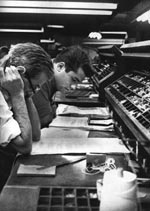
Typesetters proofing copy in The Composing Room, Inc. ca. 1964
photo Victor Laredo
PM Magazine & A-D Magazine
PM magazine began publication in 1934 and ceased in 1942 when the United States entered World War II. The publication began as a monthly journal to provide information about printing to production managers and other interested people in the field and featured articles on printing processes, typesetting and other production specific topics. The publication, which was the only non-profit, cooperative graphic arts magazine in the US, ran for a total of 66 issues and in February-March 1938 it became a bi-monthly.
 |
| PM cover by Lucian Bernhard, March 1936. |
Through its life it evolved and expanded to become one of the first publications to showcase new US born artistic talent as well as talent emigrating to the US from Europe.
The first issue to feature an artist was in March 1936. The entire front section was designed by Lucian Bernhard and featured his work as well as biographical information.
In April 1937, the editors announced their intent to devote their July or August issue entirely to the Bauhaus school. The issue was to be guest edited by Professor Josef Albers and was to feature contributions by Walter Gropius, Xanti Schawinsky, Grace Alexandra Young, William Lescaze and A. Lawrence Kocher. The importance of this issue and of the mission of the editors is summed up in the editorial notes of the announcement:
"This issue will be the most ambitious expression of the editors' belief that those engaged in a given art of design should be aware of their common interest with those in other branches if design, whether it be poster art, typography, scenic design, furniture design, or architecture."
As the magazine evolved to become a journal for art directors and designers, so too did the covers. While early covers of the journal focussed on new or interesting printing and production processes, later covers were uniquely designed, featuring a unique interpretation of the journal name, often by the feature artist of the issue.
 |
| A-D cover by Irvine Kamens, August/September 1940. |
The feature artist became a regular occurence and was one of the things that makes this periodical so important to the history of graphic design.
I have examined each issue individually and the information included on the data cards comes from these examinations. The entire run is in the collection in the Cary Library at Rochester Insitute of Technology. Selected issues, designed by important designers, are in the Special Collection Archives at Rochester Institute of Technolgy.
The Issues
September 1934
October 1934
November 1934
December 1934
January 1935
February 1935
March 1935
April 1935
May 1935
June 1935
July 1935
August 1935
September 1935
October 1935
November 1935
December 1935
January 1936
February 1936
March 1936
April 1936
May 1936
June 1936
July 1936
August 1936
September 1936
October 1936
November 1936
December 1936
January 1937
February 1937
March 1937
April 1937
May 1937
June 1937
July 1937
August 1937
September 1937
October 1937
November 1937
December/January 1937-38
February/March 1938
April/May 1938
June/July 1938
August/September 1938
October/November 1938
December/January 1938-39
February/March 1939
April/May 1939
June/July 1939
August/September 1939
October/November 1939
December/January 1939-40
February/March 1940
April/May 1940
June/July 1940
August/September 1940
October/November 1940
December/January 1940-41
February/March 1941
April/May 1941
June/July 1941
August/September 1941
October/November 1941
December/January 1941-42
February/March 1942
April/May 1942
Within the data cards, artists names are linked to their biographical information. Image thumbnails link to larger images from the magazines themselves.